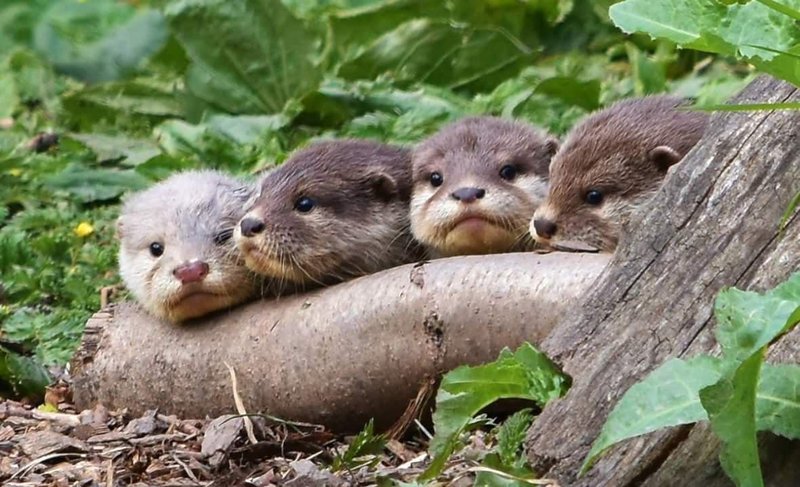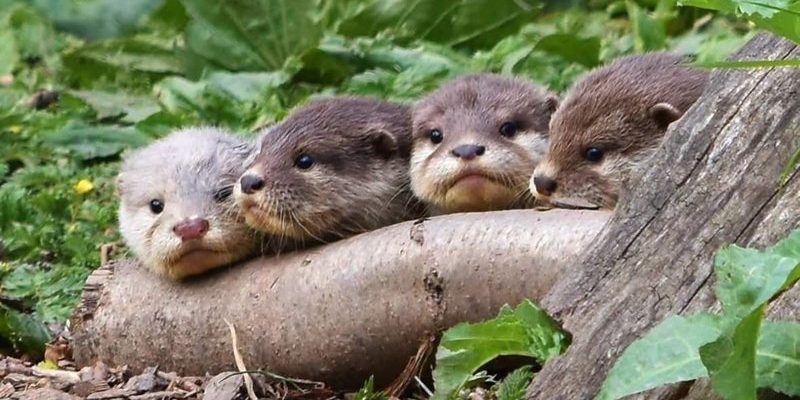
Otters are mammals that typically live in family groups known as rafts. You might think of them as the epitome of teamwork. The adults work together to provide for their young, teaching them essential life skills. Just like how you might learn different things from various friends, otter pups soak up knowledge from their parents and other family members. Let’s explore the different stages of otter parenting, from the moment the pups are born until they’re ready to swim on their own.
Otter Reproduction and Birth
Otters typically mate in winter, and after a gestation period of about two months, mama otter gives birth to a litter of 1 to 6 pups. When they first arrive, these little ones are blind and helpless, weighing just a few ounces. Here’s the thing: otter mothers are incredibly attentive during this stage. They choose secluded, sheltered spots to keep their pups safe from predators.
During their early days, the newborns are entirely dependent on their mothers for warmth and nutrition. Mama otter will nurse her pups for several months, providing them with rich milk that helps them grow strong. She’s also very protective, often staying with her pups while the rest of the family goes hunting. It’s a bit like a parent at a school event, ensuring their child interacts with the world while still keeping a watchful eye.
Creating a Safe Den
Otters usually build their dens near water sources. Mama otter looks for a cozy spot with plenty of vegetation to camouflage and protect her young. She might choose a riverbank, a section of reeds, or even an abandoned burrow.
These dens serve as both a home and a nursery for the pups. Inside, it’s all about comfort and safety. The mother lines the den with soft materials like leaves, grass, or even fur to keep the pups warm and cozy. Just like how you’d want a comfy blanket on a cold night, otter pups rely on these soft beds for warmth and security.
Learning Through Play
One of the most intriguing aspects of how otters raise their young is their emphasis on play. You might wonder why this is so important. Well, play is a critical way for otter pups to learn essential skills they’ll need later in life. Through their playful antics, they develop coordination and social skills that are vital in the wild.
As they grow, you’ll often see otter pups sliding down riverbanks, splashing in the water, and chasing one another. This playful behavior isn’t just for fun; it’s teaching them how to hunt and be agile in their environment. Just like children learn to ride a bike or swim by practicing, otter pups use these games to improve their skills.
Parenting Responsibilities
In otter families, parenting doesn’t fall solely on one adult. While the mother is primarily responsible for the pups, other adult otters in the family often pitch in. Think of it as a cooperative system. The rest of the family helps hunt, bringing back food to support the little ones.
This teamwork is crucial. When one adult is teaching the pups how to swim, another might be out foraging for food. It’s a reliable support system that ensures the pups receive consistent care and attention as they learn to navigate their world.
Teaching Survival Skills
As the pups grow older, their training becomes more focused. Mama otter starts teaching them essential survival skills, like hunting and foraging for food. She will often encourage them to accompany her while she catches fish.
You might find it fascinating that otters use tools to help with their hunting! They often use rocks to crack open shellfish. This skill isn’t just instinct; it’s learned. The mother demonstrates how to use tools, allowing the pups to observe and eventually try it themselves. It’s a valuable lesson in resourcefulness.
Socialization Among Pups
Social skills are equally as important as survival skills for otter pups. They learn how to interact with each other through play and mimicry. As they splash around and play tug-of-war with seaweed or sticks, they’re learning vital social cues that will help them get along with other otters in the future.
You might notice that otters are quite vocal; they communicate with a range of sounds. Pups learn to express themselves and understand others through these playful interactions. It’s a bit like how kids learn to share and play nicely on the playground.
Independence and Maturity
After several months, the pups begin transitioning to independence. By about six months, they’re confident enough to venture out on their own. However, they still stay close to their family. It’s not uncommon to see a young otter figuring out how to hunt while keeping an eye on its mother for guidance.
At this stage, the mother continues to teach them the ropes while letting them explore. Imagine a parent encouraging their teenager to drive alone for the first time—there’s a balance of independence and support, preparing them for adulthood.
Leaving the Family
Eventually, the pups will reach an age where they are ready to leave the nest entirely. This usually happens around 12 months old. By then, they’ve mastered essential skills, such as hunting and forming social bonds, but the family unit remains strong. If you see a group of otters in the wild, it’s often a large family, which highlights their close-knit social structure.
Once they leave, the young otters seek their own territories. They typically stay in pairs or small groups, often consisting of siblings. This behavior ensures they have a support system as they venture into the larger world, making the transition smoother.
Challenges of Otter Parenting
Raising young otters isn’t without its challenges. Like all wildlife, they face threats from predators and environmental changes. Natural predators like eagles, coyotes, and even larger fish can pose a risk to young pups. The mother’s protective instincts kick in, and she remains vigilant to keep her little ones safe.
Another challenge is environmental change. Pollution, habitat destruction, and climate change can impact the availability of food sources and safe habitats. Otters depend on healthy ecosystems, so when their environments suffer, so do they and their young.
Otter parenting is a beautiful balance of nurturing, teaching, and playful exploration. From the moment they are born, otter pups are enveloped in a world that’s rich with learning opportunities. Through teamwork, patience, and play, otters teach their young the skills needed to thrive in the wild.
The journey from helpless pups to independent otters showcases the strength of family bonds and the importance of social learning. So, the next time you see otters playing in the water, remember—there’s a whole lot of love and learning happening just below the surface.

